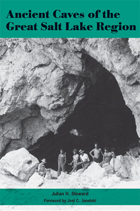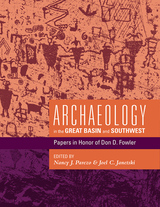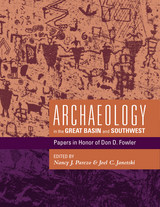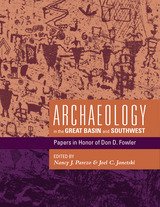4 books about Janetski, Joel C

Ancient Caves of the Great Salt Lake Region
Julian H Steward
University of Utah Press, 2009
From 1930 to 1931, the University of Utah and the Smithsonian Institute’s Bureau of American Ethnology sponsored archaeological field work in the vicinity of the Great Salt Lake. Particular attention was paid to caves that had once been submerged by Lake Bonneville, a prehistoric lake that was some 1,000 feet above the level of the remnant Great Salt Lake. Previous studies had demonstrated that such caves, as the lake subsided, were soon inhabited by ancient peoples and the archaeological explorations were aimed at discovering ancient cultures that could be dated by reference to the chronology of the lake. The field work included thorough excavations of two large caves on the western shore of Promontory Point and one large cave on the southern shore of the Great Salt Lake, as well as reconnaissance of a number of smaller caves on Promontory Point and the northern shore of Bear River Bay. The work was led by Julian Steward, who prepared this report.
First published in 1937 by the Bureau of American Ethnology, this edition of Ancient Caves of the Great Salt Lake Region features a new foreword by Joel Janetski.
First published in 1937 by the Bureau of American Ethnology, this edition of Ancient Caves of the Great Salt Lake Region features a new foreword by Joel Janetski.
[more]

Archaeology in the Great Basin and Southwest
Papers in Honor of Don D. Fowler
Nancy J. Parezo
University of Utah Press, 2014
Archaeology in the Great Basin and Southwest is a compilation of papers by friends and colleagues that honor Don D. Fowler. The volume encompasses the breadth and depth of Fowler’s work in archaeology and sister disciplines with original scholarship on the human past of the arid west. Included are theoretical, methodological, and empirical papers that synthesize and present fresh perspectives on Great Basin and Southwest archaeology and cover a sweep of topics from Paleoindian research to collaboration with Native Americans. Fowler has continually reminded scholars that to understand the past we must know how the local and specific is regionally and transculturally contextualized, how what we know came to be recognized, studied, and interpreted—in short, how the past still affects the present—and how regional and topical archaeology is part of a disciplinary endeavor that is as concerned with rigorous and inclusive knowledge production as it is with site description and cultural syntheses.
Readers will learn about the nature of archaeological careers, how archaeology has been conceptualized and conducted, the strengths and limitations of past and present approaches, and the institution building and political processes in which archaeologists engage. Contributors posit new thoughts designed to stimulate new lines of research and reflect on the state of our current knowledge about a wealth of topics. Each paper asks four questions about what Great Basin and southwestern archaeologists currently know: Where have we been? Where are we now? What do we still need to learn? Where are we going? This comprehensive volume will be of interest to those practicing or teaching archaeology and to students seeking to understand the intricacies of Great Basin and Southwest archaeology.
[more]

Archaeology in the Great Basin and Southwest, Part 2
Papers in Honor of Don D. Fowler
Nancy J. Parezo
University of Utah Press, 2014
Archaeology in the Great Basin and Southwest is a compilation of papers by friends and colleagues that honor Don D. Fowler. The volume encompasses the breadth and depth of Fowler’s work in archaeology and sister disciplines with original scholarship on the human past of the arid west. Included are theoretical, methodological, and empirical papers that synthesize and present fresh perspectives on Great Basin and Southwest archaeology and cover a sweep of topics from Paleoindian research to collaboration with Native Americans. Fowler has continually reminded scholars that to understand the past we must know how the local and specific is regionally and transculturally contextualized, how what we know came to be recognized, studied, and interpreted—in short, how the past still affects the present—and how regional and topical archaeology is part of a disciplinary endeavor that is as concerned with rigorous and inclusive knowledge production as it is with site description and cultural syntheses.
Readers will learn about the nature of archaeological careers, how archaeology has been conceptualized and conducted, the strengths and limitations of past and present approaches, and the institution building and political processes in which archaeologists engage. Contributors posit new thoughts designed to stimulate new lines of research and reflect on the state of our current knowledge about a wealth of topics. Each paper asks four questions about what Great Basin and southwestern archaeologists currently know: Where have we been? Where are we now? What do we still need to learn? Where are we going? This comprehensive volume will be of interest to those practicing or teaching archaeology and to students seeking to understand the intricacies of Great Basin and Southwest archaeology.
[more]

Archaeology in the Great Basin and Southwest, Part 3
Papers in Honor of Don D. Fowler
Nancy J. Parezo
University of Utah Press, 2014
Archaeology in the Great Basin and Southwest is a compilation of papers by friends and colleagues that honor Don D. Fowler. The volume encompasses the breadth and depth of Fowler’s work in archaeology and sister disciplines with original scholarship on the human past of the arid west. Included are theoretical, methodological, and empirical papers that synthesize and present fresh perspectives on Great Basin and Southwest archaeology and cover a sweep of topics from Paleoindian research to collaboration with Native Americans. Fowler has continually reminded scholars that to understand the past we must know how the local and specific is regionally and transculturally contextualized, how what we know came to be recognized, studied, and interpreted—in short, how the past still affects the present—and how regional and topical archaeology is part of a disciplinary endeavor that is as concerned with rigorous and inclusive knowledge production as it is with site description and cultural syntheses.
Readers will learn about the nature of archaeological careers, how archaeology has been conceptualized and conducted, the strengths and limitations of past and present approaches, and the institution building and political processes in which archaeologists engage. Contributors posit new thoughts designed to stimulate new lines of research and reflect on the state of our current knowledge about a wealth of topics. Each paper asks four questions about what Great Basin and southwestern archaeologists currently know: Where have we been? Where are we now? What do we still need to learn? Where are we going? This comprehensive volume will be of interest to those practicing or teaching archaeology and to students seeking to understand the intricacies of Great Basin and Southwest archaeology.
[more]
READERS
Browse our collection.
PUBLISHERS
See BiblioVault's publisher services.
STUDENT SERVICES
Files for college accessibility offices.
UChicago Accessibility Resources
home | accessibility | search | about | contact us
BiblioVault ® 2001 - 2024
The University of Chicago Press









